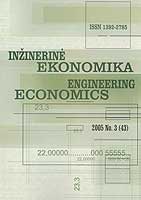Autoregressive Conditional Skewness, Kurtosis and Jarque-bera in Lithuanian Stock Market Measurement
Autoregressive Conditional Skewness, Kurtosis and Jarque-bera in Lithuanian Stock Market Measurement
Author(s): Gediminas Dubauskas, Deimantė TeresienėSubject(s): Economy
Published by: Kauno Technologijos Universitetas
Keywords: asymmetry; autoregressive; conditional; distribution; Jarque-Bera; kurtosis; skewness
Summary/Abstract: Most of the statistical tools are designed to model the conditional mean of a random variable. The tools described in this article have a rather different purpose – to model the conditional variance, or volatility of a variable. There are several reasons to model and forecast volatility. First, we need to analyze the risk of holding an asset or the value of an option. Second, forecast confidence intervals may be time-varying, so that more accurate intervals can be obtained by modeling the variance of the errors. Third, more efficient estimators can be obtained if heteroskedasticity in the errors is handled properly. Autoregressive Conditional Heteroskedasticity (ARCH) models are specifically designed to model and forecast conditional variances. The variance of the dependent variable is modeled as a function of past values of the dependent variable and independent, or exogenous variables. These models are widely used in various branches of econometrics, especially in financial time series analysis. This article analyses GARCH and ARCH models’ two main characteristics: skewness and kurtosis.
Journal: Engineering Economics
- Issue Year: 2005
- Issue No: 5 (45)
- Page Range: 19-24
- Page Count: 6
- Language: English

